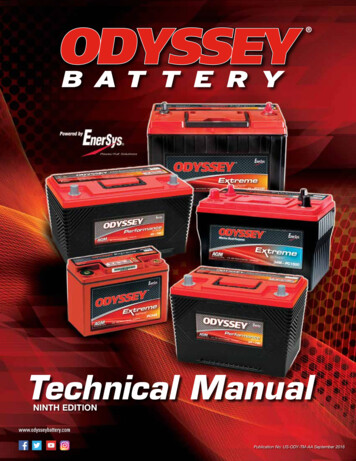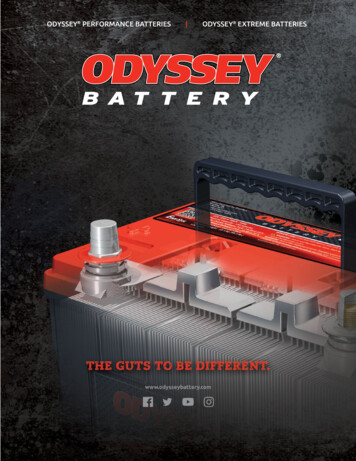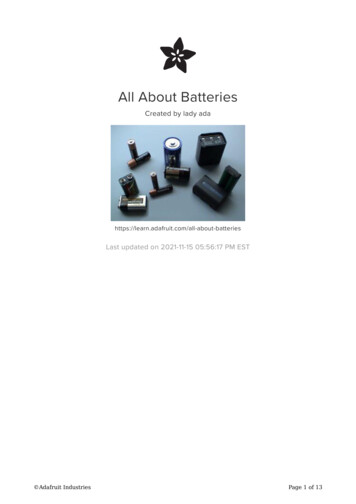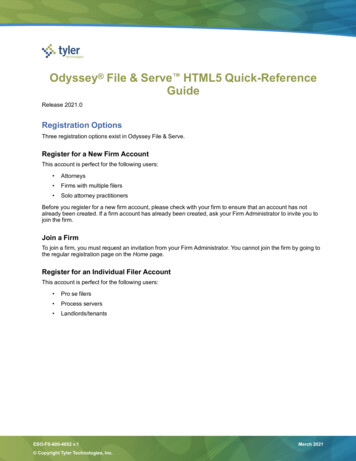
Transcription
Technical ManualNINTH EDITIONPublication No: US-ODY-TM-AA September 2016
ODYSSEY Battery Technical Manual – Ninth EditionTABLE OF CONTENTSIntroduction3Why use ODYSSEY batteries?3Preface to the Ninth EditionExtended discharge characteristics4As with previous manuals, this latestedition of the ODYSSEY BatteryTechnical Manual includes detailedperformance data for the completeline of ODYSSEY batteries. Updatedtest data will help ensure selectionof the correct battery for everyapplication.Performance data tables4In addition, this manual includesan expanded section on chargingrequirements for ODYSSEY batteries.This includes detailed informationabout the three-step charge profilethat will restore a fully dischargedbattery to optimum power in aboutsix to eight hours.You may notice that we’ve added toour lineup the ODYSSEY PerformanceSeries batteries. You’ll bepleased to know that beneaththe surface is the same industryleading technology, including ThinPlate Pure Lead (TPPL) construction,that has made ODYSSEY batteriesthe choice of automotive techniciansand consumers nationwide.2www.odysseybattery.comCycle Life and Depth of Discharge (DOD)13Float Life13ODYSSEY battery storage and deep discharge recovery(A)How do I know the State of Charge (SOC) of the battery?(B)How long can the battery be stored?(C)Can the battery recover from abusive storage conditions?(1) German DIN standard test for overdischarge recovery(2) High temperature discharged storage test131314141414Parasitic loads15Shock, impact and vibration testing(A)Caterpillar 100-hour vibration test(B)Shock and vibration test per IEC 61373, Sections 8-10151515Charging ODYSSEY batteries(A)Selecting the right charger for your battery(B)Selecting battery type on your charger151617Rapid charging of ODYSSEY batteries17Load test procedure18ODYSSEY batteries in no-idle applications18Parallel connections19Ventilation19Concluding remarks19Frequently asked SLI battery questions20Publication No: US-ODY-TM-AA September 2016
INTRODUCTIONThe ODYSSEY battery ingeniously uses Absorbed Glass Mat (AGM) Valve Regulated Lead Acid (VRLA) technology to offer,in one package, the characteristics of two separate batteries. It can deep cycle as well as deliver serious cranking power.Traditional battery designs allow them to either deep cycle or provide high amperage discharges for applications such as enginestarting. The ODYSSEY battery can support applications in either category. ODYSSEY batteries are capable of providing enginecranking pulses of up to 2,250A (PC2250) for 5 seconds at 77ºF (25ºC) as well as deliver 400 charge/discharge cycles to 80%Depth of Discharge (DOD) when properly charged. A typical Starting, Lighting and Ignition (SLI) battery, for example, is designed toprovide short-duration, high-amperage pulses; it performs poorly when repeatedly taken down to deep DOD or if they are placedon a continuous trickle charge, such as when they are used to crank a backup generator. A traditional battery resembles either asprinter or a long distance runner; an ODYSSEY battery will do both – provide short duration high amperage pulses or low rate,long duration drains.WHY USE ODYSSEY BATTERIES?Guaranteed longer service lifeWith an 8- to 12-year design life in float (emergency power) applications at 77ºF (25ºC) and a 3- to 10-year service life dependingon the nature of the non-float applications, ODYSSEY batteries save you time and money because you do not have to replacethem as often. Unlike other AGM VRLA batteries, the ODYSSEY battery is capable of delivering up to 400 cycles whendischarged to 80% DOD and properly charged.Longer storage lifeUnlike conventional batteries that need a recharge every six to 12 weeks, a fully charged ODYSSEY battery can be storedfor up to two years at 77ºF (25ºC) from a full state of charge. At lower temperatures, storage times will be even longer.Deep discharge recoveryThe ease with which an ODYSSEY battery can recover from a deep discharge is extraordinary. A later section on storage andrecharge criteria discusses test data on this important topic.Superior cranking and fast charge capabilityThe cranking power of ODYSSEY batteries is superior to that of equally sized conventional batteries, even when the temperature isas low as -40 F (-40ºC). In addition, with simple constant voltage charging there is no need to limit the inrush current, allowing thebattery to be rapidly charged. Please see the section titled Rapid charging of ODYSSEY batteries for more details on this feature.Easy shippingBecause of the starved electrolyte design, the ODYSSEY battery has been proven to meet the US Department of Transportation(USDOT) criteria for a non-spillable battery. They can be shipped by highway, air or sea as specified on our SDS that can be foundat www.odysseybattery.com.Tough constructionThe rugged construction of the ODYSSEY battery makes it suitable for use in a variety of environments ranging from marine toover-the-road trucks and powersports applications.Mounting flexibilityInstalling the ODYSSEY battery in any orientation other than inverted does not affect any performance attribute. There is also nofear of acid spillage.Superior vibration resistanceODYSSEY batteries have passed a variety of rigorous tests that demonstrate their ruggedness and exceptional tolerance ofmechanical abuse. Please see the section titled Shock, Impact and Vibration testing for more details on these tests.Ready out of the boxODYSSEY batteries ship from the factory fully charged. If the battery’s open circuit voltage is higher than 12.65V, simply install itin your vehicle and you are ready to go; if below 12.65V boost charge the battery following the instructions in this manual or theowner’s manual. For optimum reliability, a boost charge prior to installation is recommended, regardless of the battery’s OpenCircuit Voltage (OCV).www.odysseybattery.comPublication No: US-ODY-TM-AA September 20163
EXTENDED DISCHARGE CHARACTERISTICSIn addition to its excellent pulse discharge capabilities, the ODYSSEY battery can deliver many deep discharge cycles,yet another area where the ODYSSEY battery outperforms a conventional SLI battery, which can deliver only a few deepdischarge cycles.The following twenty graphs show detailed discharge characteristics of the entire ODYSSEY battery line. The end of dischargevoltage in each case is 10.02V per battery or 1.67 volts per cell (VPC). Each graph shows both constant current (CC) andconstant power (CP) discharge curves at 77ºF (25ºC). The table next to each graph shows the corresponding energy andpower densities. The battery run times extend from 2 minutes to 20 hours.ODYSSEY Extreme Series BatteriesPC310 performance data at 77 F, per 12V modulePC370 performance data at 77 F, per 12V module10000Watts or amps per 12V unit10001001010.10.010.11Hours to 10.02V @ 77 C (25 C)4www.odysseybattery.com10100TimeWatts(W)Amps(A)2 min5 min10 min15 min20 min30 min45 min1 hr2 hr3 hr4 hr5 hr8 hr10 hr20 32076848536529722016112873514033211892 min5 min10 min15 min20 min30 min45 min1 hr2 hr3 hr4 hr5 hr8 hr10 hr20 hrCapacity 7.67.88.6ENERGY AND POWER DENSITIESW/liter Wh/liter 1.863.533.722.917.414.08.97.23.8Amps 3.325.727.428.330.030.731.031.331.932.233.5ENERGY AND POWER DENSITIESPublication No: US-ODY-TM-AA September 2016
2 min5 min10 min15 min20 min30 min45 min1 hr2 hr3 hr4 hr5 hr8 hr10 hr20 tts(W)Amps(A)2 min5 min10 min15 min20 min30 min45 min1 hr2 hr3 hr4 hr5 hr8 hr10 hr20 ts(W)Amps(A)2 min5 min10 min15 min20 min30 min45 min1 hr2 hr3 hr4 hr5 hr8 hr10 hr20 ity 6.8142.1150.0155.1158.6168.6171.2177.3Capacity 124.0130.7135.3138.6148.6151.9162.7Capacity 03.8207.9219.8ENERGY AND POWER DENSITIESW/liter Wh/liter GY AND POWER DENSITIESW/liter Wh/liter GY AND POWER DENSITIESW/liter Wh/liter 35 performance data at 77 F, per 12V module10000Watts or Amps per 12V unitAmps(A)10001001010.10.010.1110100Hours to 10.02V @ 77 F (25 C)PC545 performance data at 77 F, per 12V module10000Watts or Amps per 12V unitWatts(W)10001001010.10.010.1110100Hours to 10.02V @ 77 F (25 C)PC625 performance data at 77 F, per 12V module10000Watts or Amps per 12V unitTime10001001010.10.010.1110100Hours to 10.02V @ 77 F (25 C)Publication No: US-ODY-TM-AA September 20165
PC680 performance data at 77 F, per 12V module10000Watts or Amps per 12V unit10001001010.10.010.1110100Hours to 10.02V @ 77 F (25 C)PC925 performance data at 77 F, per 12V moduleWatts or Amps per 12V unit1000010001001010.10.010.1110100Hours to 10.02V @ 77 F (25 C)PC950 performance data at 77 F, per 12V module10000Watts or amps per 12V unit10001001010.10.010.11Hours to 10.02V @ 77 C (25 C)6www.odysseybattery.com10100Capacity Energy(Ah)(Wh)ENERGY AND POWER DENSITIESW/liter Wh/liter W/kgWh/kgTimeWatts(W)Amps(A)2 min5 min10 min15 min20 min30 min45 min1 hr2 hr3 hr4 hr5 hr8 hr10 hr20 atts(W)Amps(A)2 min5 min10 min15 min20 min30 min45 min1 hr2 hr3 hr4 hr5 hr8 hr10 hr20 )Capacity(Ah)Energy(Wh)ENERGY AND POWER DENSITIESW/litre Wh/litre W/kgWh/kg2 min5 min10 min15 min20 min30 min45 min1 hr2 hr3 hr4 hr5 hr8 hr10 hr20 .9170.5174.7187.2191.4204.9Capacity ENERGY AND POWER DENSITIESW/liter Wh/liter .836.637.638.740.541.345.3Publication No: US-ODY-TM-AA September 2016
2 min5 min10 min15 min20 min30 min45 min1 hr2 hr3 hr4 hr5 hr8 hr10 hr20 hrENERGY AND POWER 4.251.8PC1100 performance data at 77 F, per 12V module100001000Watts or amps per 12V unitTime1001010.10.010.1110100Hours to 10.02V @ 77 C (25 C)Amps(A)2 min5 min10 min15 min20 min30 min45 min1 hr2 hr3 hr4 hr5 hr8 hr10 hr20 TimeWatts(W)Amps(A)Capacity(Ah)Energy(Wh)ENERGY AND POWER DENSITIESW/litre Wh/litre W/kgWh/kg2 min5 min10 min15 min20 min30 min45 min1 hr2 hr3 hr4 hr5 hr8 hr10 hr20 .837.840.2PC1200 performance data at 77 F, per 12V module100001000Watts or Amps per 12V unitWatts(W)1001010.10.010.1110100Hours to 10.02V @ 77 F (25 C)PC1220* performance data at 77 F, per 12V module100001000Watts or amps per 12V unitCapacity Energy(Ah)(Wh)ENERGY AND POWER DENSITIESW/liter Wh/liter W/kgWh/kgTime1001010.10.010.1110100Hours to 10.02V @ 77 C (25 C)*PC1220 no longer distributed in the United States.www.odysseybattery.comPublication No: US-ODY-TM-AA September 20167
75-PC1230 and 75/86-PC1230 performance data at 77 F,per 12V moduleTime10000Watts or Amps per 12V unit10001001010.10.010.1110100Hours to 10.02V @ 77 F (25 C)PC1350 performance data at 77 F, per 12V module10000Watts or amps per 12V unit10001001010.10.010.1110100Hours to 10.02V @ 77 C (25 C)25-PC1400 and 35-PC1400 performance data at 77 F,per 12V moduleWatts or Amps per 12V unit10001001010.010.11Hours to 10.02V @ 77 F (25 C)8www.odysseybattery.com10Amps(A)2 min5 min10 min15 min20 min30 min45 min1 hr2 hr3 hr4 hr5 hr8 hr10 hr20 9.8112.182.565.837.326.420.516.811.19.04.82 min5 min10 min15 min20 min30 min45 min1 hr2 hr3 hr4 hr5 hr8 hr10 hr20 hrTime100000.1Watts(W)1002 min5 min10 min15 min20 min30 min45 min1 hr2 hr3 hr4 hr5 hr8 hr10 hr20 hrCapacity 5.4573.8588.1633.0649.9713.3ENERGY AND POWER DENSITIESCapacity 79.182.084.288.590.596.5ENERGY AND POWER 739.541.9Capacity NERGY AND POWER 329.129.831.932.735.7Publication No: US-ODY-TM-AA September 2016
2 min5 min10 min15 min20 min30 min45 min1 hr2 hr3 hr4 hr5 hr8 hr10 hr20 .57.76.33.5TimeWatts(W)Amps(A)2 min5 min10 min15 min20 min30 min45 min1 hr2 hr3 hr4 hr5 hr8 hr10 hr20 .9122.389.164.151.528.419.915.412.78.57.03.82 min5 min10 min15 min20 min30 min45 min1 hr2 hr3 hr4 hr5 hr8 hr10 hr20 hrCapacity apacity 9.060.862.166.468.073.6ENERGY AND POWER DENSITIESW/liter Wh/liter RGY AND POWER DENSITIESW/liter Wh/liter city .531.9ENERGY AND POWER DENSITIES34-PC1500, 34R-PC1500, 34M-PC1500, 34/78-PC1500 and78-PC1500 performance data at 77 F, per 12V module10000Watts or Amps per 12V unitAmps(A)10001001010.10.010.1110100Hours to 10.02V @ 77 F (25 C)PC1700 performance data at 77 F, per 12V module100001000Watts or Amps per 12V unitWatts(W)1001010.10.010.1110100Hours to 10.02V @ 77 F (25 C)65-PC1750 performance data at 77 F, per 12V module100001000Watts or Amps per 12V unitTime1001010.10.010.1110100Hours to 10.02V @ 77 F (25 )Publication No: US-ODY-TM-AA September 20169
PC1800-FT performance data at 77 F, per 12V moduleTime10000Watts or amps per 12V unit10001001010.10.010.1110100Hours to 10.02V @ 77 C (25 C)31-PC2150 and 31M-PC2150 performance data at 77 F,per 12V moduleTime10000Watts or Amps per 12V unit10001001010.10.010.1110100Hours to 10.02V @ 77 F (25 C)PC2250 performance data at 77 F, per 12V module10000Watts or amps per 12V unit10001001010.10.010.11Hours to 10.02V @ 77 C (25 C)10www.odysseybattery.com102 min5 min10 min15 min20 min30 min45 min1 hr2 hr3 hr4 hr5 hr8 hr10 hr20 hr100ENERGY AND POWER .824.626.531.233.334.835.537.639.042.0ENERGY AND POWER ter Wh/literW/kgWh/Kg2 min5 min10 min15 min20 min30 min45 min1 hr2 hr3 hr4 hr5 hr8 hr10 hr20 Amps(A)2 min5 min10 min15 min20 min30 min45 min1 hr2 hr3 hr4 hr5 hr8 hr10 hr20 25.020.613.811.46.3Capacity 672.974.679.881.687.8ENERGY AND POWER DENSITIESW/liter Wh/liter ublication No: US-ODY-TM-AA September 2016
ODYSSEY Performance Series BatteriesENERGY AND POWER terW/kgWh/Kg2 min5 min10 min15 min20 min30 min45 min1 hr2 hr3 hr4 hr5 hr8 hr10 hr20 W/kgWh/Kg2 min5 min10 min15 min20 min30 min45 min1 hr2 hr3 hr4 hr5 hr8 hr10 hr20 25.728.730.231.232.034.335.137.72 min5 min10 min15 min20 min30 min45 min1 hr2 hr3 hr4 hr5 hr8 hr10 hr20 hrwww.odysseybattery.com31-800 performance data at 77 F, per 12V module10000Watts or Amps per 12v unitWatts(W)10001001010.010.1110100Hours to 10.02v at 77 F (25 C)ENERGY AND POWER DENSITIES34-790, 34R-790 and 78-790 performance data at 77 F,per 12V moduleWatts or Amps per 12v unit1000010001001010.010.1110100Hours to 10.02v at 77 F (25 C)ENERGY AND POWER DENSITIES48-720 performance data at 77 F, per 12V module10000Watts or Amps per 12v unitTime10001001010.010.1110100Hours to 10.02v at 77 F (25 C)Publication No: US-ODY-TM-AA September 201611
75/86-705 performance data at 77 F, per 12V moduleTimeWatts or Amps per 12v unit1000010001001010.010.1110100Hours to 10.02v at 77 F (25 C)65-760 performance data at 77 F, per 12V moduleTimeWatts or Amps per 12v unit1000010001001010.010.11Hours to 10.02v at 77 F (25 C)12www.odysseybattery.com102 min5 min10 min15 min20 min30 min45 min1 hr2 hr3 hr4 hr5 hr8 hr10 hr20 hr1002 min5 min10 min15 min20 min30 min45 min1 hr2 hr3 hr4 hr5 hr8 hr10 hr20 hrENERGY AND POWER ENERGY AND POWER 9Publication No: US-ODY-TM-AA September 2016
CYCLE LIFE AND DEPTH OFDISCHARGE (DOD)FLOAT LIFEApplications in which the battery is frequently dischargedand recharged are called cyclic. A complete cycle starts witha charged battery that is discharged and then brought backto a full state of charge. Battery life in these applications isstated as the number of cycles the battery will deliver beforeits capacity drops to 80% of its rated value. For example,suppose a battery is rated at 100 amp-hours (Ah) and has apublished cycle life of 400. This means that the battery canbe cycled 400 times before its delivered capacity drops to80Ah.Proper charging and DOD are the two key factors thatdetermine how many cycles a battery will deliver before itreaches end of life. The DOD is simply the ratio of capacityextracted from the battery to its rated capacity expressed asa percentage. If a 100Ah battery delivers 65Ah and is thenrecharged, it is said to have delivered a 65% DOD cycle.Float life refers to the life expectancy of a battery that isused primarily as a source of backup or emergency power.Emergency lighting, security alarm and UninterruptiblePower Systems (UPS) are good examples of batteries infloat applications. In each of these applications the battery isdischarged only if the main utility power is lost; otherwise thebattery remains on continuous trickle charge (also called floatcharge).Since ODYSSEY batteries are dual purpose by design, theyoffer a long-life battery option in float applications. At roomtemperature (77 F or 25 C) these batteries have a design lifeof 10 years in float applications; at end of life an ODYSSEYbattery will still deliver 80% of its rated capacity.ODYSSEY BATTERY STORAGE ANDDEEP DISCHARGE RECOVERYThe relationship between DOD and cycle life for ODYSSEY batteries, excluding PC370, PC950 and PC1100, is shownin Figure 1. The lower the DOD the higher the number ofcycles the battery will deliver before reaching end of life.For any rechargeable battery, storage and recharge areimportant criteria. This section provides some guidelinesthat will help you get the most from your ODYSSEY battery.Figure 1(A) How do I know the State of Charge (SOC) of thebattery?Use Figure 2 to determine the SOC of the ODYSSEYbattery, as long as the battery has not been charged ordischarged for six or more hours. The only tool needed isa good quality digital voltmeter to measure its OCV1. Thegraph shows that a healthy, fully charged ODYSSEY batterywill have an OCV of 12.84V or higher at 77ºF (25ºC).1000000Charge profile:CV@2.45 VPC for 16 hoursCurrent limit at 1CNunmber of cycles10000010000Figure 2: Open circuit voltage and state of charge100013.012.84V or higher indicates 100% SOC12.81003020504070608090100Depth of discharge, DOD%The true dual purpose design of ODYSSEY batteries isreflected in the cycle life results shown in the graph below.This graph is from an 80% DOD cycle test completed ontwo ODYSSEY 65-PC1750 battery samples. Both samplesgave over 500 cycles before failing to give 80% capacity(this is classified as end of life.)Open circuit voltage (OCV), V10012.612.412.212.011.811.61020304050
2 www.odysseybattery.com Publication No: US-ODY-TM-AA September 2016 ODYSSEY Battery Technical Manual - Ninth Edition TABLE OF CONTENTS Introduction 3 Why use ODYSSEY batteries? 3 Extended discharge characteristics 4 Performance data tables 4 Cycle Life and Depth of Discharge (DOD) 13 Float Life 13 ODYSSEY battery storage and deep discharge recovery 13 (A) How do I know the State of .










